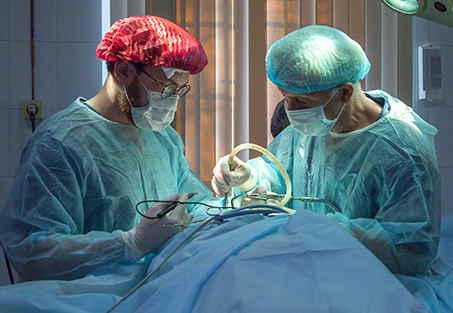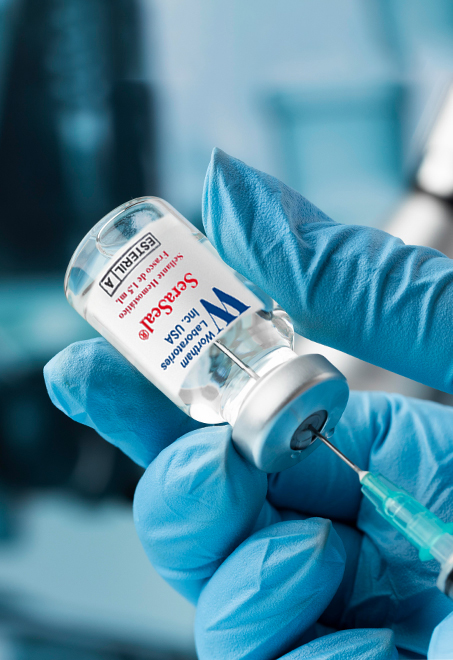What is SeraSeal™?
A new and innovative hemostatic agent that is designed to stop bleeding on contact, and within seconds for arterial hemorrhages.

Have you wondered how many deaths occur every year because of uncontrolled bleeding? Did you know hemorrhage is the leading cause of death worldwide! Hemorrhages can be in the form of uncontrolled bleeding after an accident or controlled bleeding, for example during surgery. Acute bleeding during surgical interventions often results in unforeseen complications.
Swasth Kare launches a revolutionary new innovation from Wortham Laboratories SeraSeal™ to stop any kind of bleeding in seconds including arterial bleeds.
SeraSeal™ is the World’s ONLY Primary Hemostatic Agent, that stops major hemorrhages in seconds, even in the presence of anticoagulant therapy or factor deficiencies, without the need for ANY of the traditional applications of pressure, elevation, tourniquets, or cauterization. SeraSeal™ is derived from bovine factors and can be applied by a syringe, spray, catheter, foam, trauma dressing, surgical sponge, bandage-strip, or a swab. All products are stable with long shelf lives, require no preparation, and are immediately applicable to the patient. SeraSeal™ does not create chemical burns, but rather, accelerates healing for the patient.
By contrast, all conventional products in the healthcare space are secondary hemostatic agents, effective only for minor bleeds. Generally, they require direct pressure, cauterization, and some are limited to external use only.
Proven Effectiveness
The effectiveness of Seraseal™ has been demonstrated in several studies. Even in difficult-to-control hemorrhages in the gastrointestinal area, bleeding was completely stopped in 87% of patients through the use of the Seraseal™ India Hemostasis agent. Seraseal™ has also been demonstrated to minimize blood loss and the necessity for blood transfusions during corrective osteotomies in craniosynostosis surgery.
Seraseal™ supports the body’s own blood coagulation process, acts as a catalyst in the clot formation process, and stops bleeding within 10-30 seconds without the application of pressure. It contains agar, an inert polysaccharide/carbohydrate, and coregulation factors (IIa, VIIa, IXa, and Xa) derived from bovine plasma.
How Every Stage Of Healthcare Will Be Improved!
Seraseal™ is the world’s first primary hemostatic agent that arrests bleed within seconds! By reducing blood loss, whole blood units needed, time in surgery, and precious tissue, every stage of healthcare is substantially impacted. If we truly place the lives of patients at the forefront, we use Seraseal™ to stop bleeding whether in the hands of first responders or in the surgical theater. We save countless thousands of hours of clinical time, reduce post-op pain management and preserve tissue. Patients, medical professionals, insurance companies, governments, military troops all benefit from this product which saves both lives and money.
Seraseal™ supports the body’s own blood coagulation process, acts as a catalyst in the clot formation process, and stops bleeding within 10-30 seconds without the application of pressure. It contains agar, an inert polysaccharide/carbohydrate, and coregulation factors (IIa, VIIa, IXa, and Xa) derived from bovine plasma.
Benefits of SeraSeal™ Over Other Similar Heamostatic Agents
Seraseal™ is superior in efficacy and safety to arrest bleeds over current hemostatic and tissue sealant products being used.Seraseal™ can reduce surgical time by as much as 50% in some cases, and blood transfusion by 90% (in upto 40% surgical procedures), resulting in substantial cost savings. In addition, Seraseal™ has multiple delivery systems, and it can be delivered by a syringe, spray, foam, scope, trochar, catheter, trauma dressing, battlefield dressing, surgical sponges, dental compresses, swabs, and bandage strip. These delivery systems substantially expand the hemostatic market to include hospitals, ER/trauma centers, medical and surgical clinics, private practice, dentistry, veterinarian medicine, paramedics, military, law enforcement, and over the counter products in the form of first-aid products for the home, business, recreational and sporting events.
- Seraseal™ does not obstruct the view of the bleeding site
- Excellent for highly vascular organs
- Excellent at the point of anastomosis
- Seraseal™ has multiple delivery mechanisms including portal wounds
- Seraseal™ is active in the presence of anticoagulants
- Active in the presence of factor deficiencies
- It has no limit to age or tissue type
- No limit to market segment
- Seraseal™ has no side effects ‘ and or adverse reactions
- It has Specific Gravity of 1.02
No preparation required for the patient before application Reduces blood transfusion up to 90 percent in upto 40% surgical procedures.

Significants Advantages of Using SeraSeal™ Over Other Contemporary Products

With SeraSeal™ , Hemostasis occurs within seconds:
- Venous bleeds: 1-3 seconds
- Small artery: 5-10 seconds
- Medium artery: 15-30 seconds
- Large artery: <60 Seconds
SeraSeal™ is a primary hemostatic product, and it can be used in place of cauterization, or in concert with cauterization (*cauterization: to burn something like a wound, with heat or chemical substance in order to destroy infected tissue. Electrocauterization is used in surgery to remove unwanted or harmful tissue. It can also be used to burn and seal blood vessels. This helps reduce or stop bleeding during surgery or after an injury.)
It is Effective in all forms of coagulopathy: anticoagulant drugs, platelet inhibitors, factor deficiency. (Platelet inhibitors: Antiplatelet drug (antiaggregant), also known as platelet agglutination or platelet aggregation inhibitor, is a member of a class of pharmaceuticals that decreases platelet aggregation and inhibits thrombus formation. They are effective in arterial circulation where anticoagulants have little effect.)
SPECIFIC FEATURE- SeraSeal™ is also effective with patients under anticoagulation therapy Phenprocoumon/MarcumarR) and/or with coagulation factor deficiencies. Affected patients can continue their treatment with coagulation inhibitors.
How to Use SeraSeal™ Overview
SeraSeal™ is applied topically to the bleeding site and NEVER injected into the vascular system. After applying the hemostatic agent leave it undisturbed for 1 minute. Do not wipe. Work in another area during this 1 minute period while the fibrin strands cross-link to create a stronger tensile strength clot. After a minute irrigate or gently dab the fibrin clot to check for any hidden bleeding. If there is a hidden bleed, repeat the above process.
SeraSeal™ Use Outside the Clinical Setting
SeraSeal™’s ability to control Level 3 and Level 4 type hemorrhages, such as from the iliac or femoral artery, and the agent’s one component delivery system, make it uniquely qualified to treat life-threatening wounds outside the clinical setting. Application of SeraSeal™ out in the field will significantly reduce the number of incidences of hypotensive cases, and lessen the need for infusion of blood products. If blood products are needed for the restoration of the blood pressure on SeraSeal™ treated patients, the fibrin clot will remain in situ.
Two SeraSeal™ delivery systems are recommended for field use: SeraSeal™ Battlefield Dressing and SeraSeal™ Foam. The battlefield dressing is recommended for all open and gaping wounds, and the foam is designed to arrest hemorrhages in a closed cavity, such as gunshot or impalement wounds.


Product Description
Active Agents:
Agar, Factors IIa, VIIa, IXa, Xa
Description:
Agar: used in gelatin, emulsifier, thickening, and gelling agents, is a polysaccharide/carbohydrate or linear complex sugar made from beta-galactopyranose linked to 3,6-anhydro-L-galctopyranose Bovine Factors IIa, VIIa, IXa, Xa (0.14 mg/ml): serine proteases
Mechanism:
Agar, the complex sugar in SeraSeal™, when added to a bleeding wound, will cross-link with the ions of platelet phospholipids, and cations from amine groups in fibrinogen/fibrin monomers and tissue proteins, forming an α-1,6- linked galactophospho and α-1,6-galactoamine forming a gelatin barrier over the wound. This barrier reduces blood from escaping through the opening of the wound, allowing the patient’s cascade system to form a fibrin clot sooner. The Factors IIa, VIIa, IXa, and Xa, function in an ancillary way, by facilitating the agar to cross-link with the platelets and fibrinogen, lending strength to the gelatin barrier, and by biologically facilitating only the blood outside of the wound, to facilitate the formation of a fibrin clot. The clotting cascade is a biological activity system, and the clotting factors in the product are participating in this biological activity as a catalyst to form a fibrin clot.
The activated platelets do an internal surface translocation, where more phospholipids are available to cross-link with agar, and where covalent lysine to glutamine linkages between gamma chains of adjacent fibrin molecules and between adjacent alpha chains, create clot stabilization.
The activation of the coagulation cascade system begins with the release of thromboplastin from the injured tissue. Thromboplastin will then bind to the serine protease Factor VII, activating the extrinsic coagulation pathway at the site of injury. Factor VIIa, in turn, will cleave Factor X to Factor Xa in the same manner to that of Factor IXa of the intrinsic pathway. The activation of Factor VII occurs through the action of thrombin or Factor Xa. The ability of Factor Xa to activate Factor VII creates a link between the intrinsic and extrinsic pathways. An additional link between the two pathways exists through the ability of tissue factor and Factor VIIa to activate Factor IX.

The common point in both pathways is the activation of Factor X to Factor Xa. Factor Xa activates prothrombin (FII) to thrombin (FIIa). Thrombin, in turn, coverts fibrinogen (Factor I) to fibrin. The activation of thrombin occurs on the surface of activated platelets and requires formation of a prothrombinase complex. This complex is composed of the platelet phospholipids, phosphatidylinositol and phosphatidylserine, calcium, Factors Va and Xa, and prothrombin. Factor V is a cofactor in the formation of the prothrombinase complex, similar to the role of Factor VIII in the intrinsic tenase complex formation. Like Factor VIII activation, Factor V is activated to FVa by means of minute amounts of thrombin and inactivated by increased levels of thrombin. Factor Va binds to the GP1b receptor site of the activated platelets and forms a complex with prothrombin and Factor Xa.
The active agents in SeraSeal™: agar, Factors IIa, VIIa, IXa, and Xa, are effective to overcome a wide range of coagulopathies, due to platelet inhibitors, anticoagulant medications, and factor deficiencies. Platelet inhibitors, such as clopidogrel, ticagrelor, prasugrel, and aspirin, bind to a specific receptor site on the platelet, while agar binds to platelet phospholipids, by-passing the inhibitor effects of treated platelets. When SeraSeal™ is applied to a bleeding wound in a patient on heparin or warfarin therapy, untreated Factor IXa and Factor VIIa in the hemostatic agent, bridges the inhibited intrinsic and extrinsic coagulation pathway, respectively. Likewise, when there is a factor deficiency anywhere in the coagulation cascade system, the serine proteases in SeraSeal™ will bridge the deficiency in the extrinsic pathway at Factor VII, in the intrinsic pathway at Factor IX, and in the common pathway at Factor X and Factor II sites.

Indications and usage:
SeraSeal™ is indicated for controlling hemorrhages for most forms of bleeding (arterial and venous), occurring in invasive and noninvasive procedures. SeraSeal™ is an effective hemostatic agent in fully anticoagulant and factor deficient patients. Remove SeraSeal™ from the freezer and place on a counter at room temperature (20°-25°C) to thaw 30 minutes before surgery. To quickly thaw a unit of SeraSeal™, place the vial in sterile water (25°C) for 2-3 minutes. If SeraSeal™ is not used, place it back into the freezer (-10°C to -70°C). The stabilizers in SeraSeal™ allow the product to undergo up to 10 repetitive freeze-thaw cycles without losing its activity. Dispose with biological waste.
Directions for use:
Wipe bleeding area to visualize the bleeding site.
Apply SeraSeal™ drop wise to the surface of the bleeding site until bleeding stops. For deep wounds, first apply SeraSeal™ to the base of the wound, continually applying the agent as you draw it up from the wound. This assures the arrest of hemorrhage below the surface.
No local pressure is needed.
DO NOT WIPE. Wait 60 seconds to allow the clot to crosslink. This gives greater tensile strength to fibrin strands. Premature wiping may restart the bleeding.
If a second application of SeraSeal™ is required, repeat steps 2 through 4. 6. After hemostasis has occurred remove SeraSeal™ by irrigation/suction or absorption onto a surgical sponge.
Contraindications:
SeraSeal™ is contraindicated in individuals who are known to be hypersensitive to bovine proteins. Precautions: For single use only. Do not resterilize. As with other hemostatic agents, do not allow SeraSeal™ to enter into cell saver equipment, extracorporeal cardiopulmonary bypass circuits or autologous blood salvage circuits. The active proteins in SeraSeal™ will pass through 40 µm transfusion filters of blood. Avoid high temp and X-ray.
Warning:
Not to be injected intravascularly. This may cause a thromboembolic event, which may be life
threatening. If SeraSeal™ should fail to arrest the hemorrhage, switch to standard surgical methods to control bleeding.
Adverse reactions:
As with any other plasma derivatives, anaphylactic reactions may occur in rare cases. No adverse events of this type were observed during the course of clinical studies. Mild reactions can be managed with antihistamines. In the case of hypersensitivity to bovine proteins after repeated administration, allergic or anaphylactic reactions can occur on rare occasions.
Risk Class and Classification
Class D, Rule 14
SeraSeal™ Configuration and Identification
- 4003-1-B SeraSeal™ Hemostatic Agent 3 ml vial
- 4003-1-C SeraSeal™ Hemostatic Agent 5 ml vial
- 4003-4-1 Foam Hemostatic Agent 30 ml canister
SeraSeal™ Indication
SeraSeal™ is indicated in all surgical procedures as a primary to hemostasis when control of bleeding by cauterization, ligature, or conventional procedures is ineffective or impractical.
Important Risk Information For SeraSeal™
SeraSeal™ must NOT be injected into blood vessels or allowed to enter blood vessels. This may lead to extensive intravascular clotting or even death.
